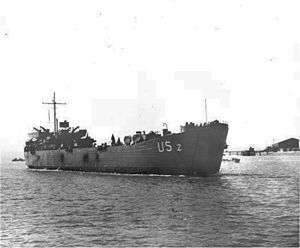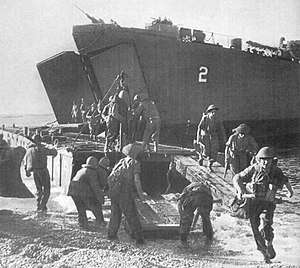USS LST-2
USS LST-2 was an LST-1-class tank landing ship of the United States Navy built during World War II. She was transferred to the Royal Navy in November 1944. Like many of her class, she was not named and is properly referred to by her hull designation.
 USS LST-2 under way, location unknown, c. January–June 1944. | |
| History | |
|---|---|
| Name: | LST-2 |
| Builder: | Dravo Corporation, Pittsburgh, Pennsylvania |
| Laid down: | 23 June 1942 |
| Launched: | 19 September 1942 |
| Sponsored by: | Nancy Jane Hughes |
| Commissioned: | 22 December 1942 |
| Decommissioned: | 29 November 1944 |
| Identification: |
|
| Honors and awards: |
|
| Fate: | Transferred to the Royal Navy, 29 November 1944 |
 | |
| Name: | LST-2 |
| Acquired: | 29 November 1944 |
| Commissioned: | 29 November 1944 |
| Decommissioned: | 11 April 1946 |
| Status: | Returned to US Naval custody, 13 April 1946 |
| Acquired: | 13 April 1946 |
| Stricken: | 5 June 1946 |
| Fate: | Sold, 5 December 1947 |
| Status: | Fate unknown |
| General characteristics | |
| Type: | LST-1-class tank landing ship |
| Displacement: |
|
| Length: | 328 ft (100 m) oa |
| Beam: | 50 ft (15 m) |
| Draft: |
|
| Installed power: |
|
| Propulsion: |
|
| Speed: | 12 kn (22 km/h; 14 mph) |
| Range: | 24,000 nmi (44,000 km; 28,000 mi) at 9 kn (17 km/h; 10 mph) while displacing 3,960 long tons (4,024 t) |
| Boats & landing craft carried: | 2 x LCVPs |
| Capacity: | 1,600–1,900 short tons (3,200,000–3,800,000 lb; 1,500,000–1,700,000 kg) cargo depending on mission |
| Troops: | 16 officers, 147 enlisted men |
| Complement: | 13 officers, 104 enlisted men |
| Armament: |
|
| Service record | |
| Operations: |
|
Construction
LST-2 was laid down on 23 June 1942, at Pittsburgh, Pennsylvania by the Dravo Corporation; launched on 19 September 1942; sponsored by Nancy Jane Hughes; and commissioned on 9 February 1943, with Lieutenant John P. Hogan, USNR, in command.[2]
USN service history
LST-2 was assigned to the European Theater and participated in the following operations: North African occupation prior to July 1943; Allied invasion of Sicily in July 1943; Salerno Landings in September 1943; and the Invasion of Normandy in June 1944.[2]
Royal Navy service
LST-2 was decommissioned from the USN and commissioned into the Royal Navy on 29 November 1944, as HM LST-2. She performed sea trials December 1944, in Scotland. She then prepared for Far East service between December 1944 and August 1945, at Tyne. LST-2 sailed from Southampton on 17 August 1945, for Bombay, India, via Port Said, Egypt, and the Suez Canal, arriving at her destination on 21 September 1945. She had railroad tracks installed and made various trips between the ports of Madras, India, Singapore, and Trincomalee, Sri Lanka. She was returned to the US Navy in Subic Bay on 13 April 1946, and struck on 5 June 1947.
Final disposition
LST-2 was decommissioned on 11 April 1946, and was struck from the Navy list on 5 June 1946. On 5 December 1947, she was sold to Bosey, Philippines.[2]
Awards
LST-2 earned four battle stars for World War II service.[2]
References
Bibliography
- "LST-2". Dictionary of American Naval Fighting Ships. Naval History and Heritage Command. 30 July 2015. Retrieved 11 August 2017.

- "LST-2". Navsource. Navsource.org. 18 April 2014. Retrieved 11 August 2017.
External links
| Wikimedia Commons has media related to USS LST-2. |
- Photo gallery of USS LST-2 at NavSource Naval History
- http://www.criticalpast.com/stock-footage-video/horgan